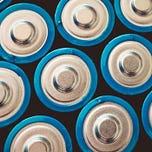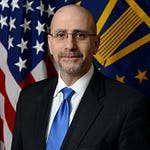Podcast Summary: In this episode, Moshiel Biton, CEO and co-founder of Addionics, shares his journey from material science to pioneering battery technology, addressing the critical need for more efficient and longer-lasting batteries in today's energy-dependent world. He explains Addionics' innovative approach to improving lithium-ion batteries by replacing the traditional 2D metal foil current collectors with 3D porous structures, resulting in enhanced efficiency, longer life, and faster charging. Biton discusses the impact on the automotive industry, the role of strategic versus financial investors, and the challenges in scaling up production. He highlights the transformative potential of their technology in the evolving battery market and the broader electrification revolution.
Transcript: Inside Addionics' Quest To Remake Battery Technology
Transcript edited for clarity, grammar, and readability
Amir Mizroch: Let's start with the basics. Name, rank, unit—give us an intro to yourself and then we'll go into the company.
Moshiel Biton: Hi Amir. Thank you very much for having me. My name is Moshiel, and I am the CEO and co-founder of Addionics. My background is in materials science, mainly semiconductors. Over a decade ago, I moved into the battery space and earned a PhD at Imperial College London. That’s how I entered the battery world.
Amir Mizroch: That’s right, we met back in 2014 or 2015. You were telling me about your PhD work on extending battery life. I remember thinking, "This guy's really smart—just try to stay with him." And lo and behold, 10 years later, you're running Addionics, a battery tech company. Tell us about it—how many people, where are you based, and what's the funding like?
Moshiel Biton: We’re 90 employees, mostly based in Tel Aviv, with teams in California and Europe. We've raised more than $80 million from a mix of strategic and financial investors. Strategic investors include General Motors, Scania (Volkswagen Group), Avery Dennison, Novelis, Nippon, and Magna.
Amir Mizroch: What’s the difference between a strategic and a financial investor?
Moshiel Biton: Strategic investors are looking for more than financial returns. They want strategic value—whether that’s integrating the product into their supply chain, becoming future customers, or gaining a competitive edge. Financial investors focus only on ROI—they don’t intend to use the product themselves.
Amir Mizroch: Let's get into the core idea behind Addionics.
Moshiel Biton: We’re developing a smart 3D porous current collector—a key component in every battery. Traditionally, this is a flat copper foil on the anode side and aluminum on the cathode side. This architecture hasn't changed since lithium-ion batteries were invented. Even Tesla uses the same old structure. We’re changing that. Our 3D design allows better performance—more energy, faster charging, longer life, and lower heat.
Amir Mizroch: Can we zoom out? Batteries power everything that's not plugged into a wall. Cars, bikes, drones, ships—you name it. Your idea is that this long-standing battery architecture could be vastly improved, correct?
Moshiel Biton: Yes. A battery is a closed system. Unlike an engine, you don’t fuel it—you recharge it. Electrons move from one electrode to the other, and the structure of the battery determines how efficiently that happens. Our design makes that process much more efficient.
Amir Mizroch: And how does that work in real-world applications like cars or ambulances?
Moshiel Biton: Traditional internal combustion vehicles use low-cost, low-energy batteries like lead-acid. But electric vehicles need high-energy batteries that last longer and charge faster. That’s where our technology makes a difference. We reduce internal resistance and improve thermal management.
Amir Mizroch: What's the trade-off between power and energy?
Moshiel Biton: Power is how fast you can discharge energy; energy is how much total charge you store. Traditionally, batteries are optimized for one or the other. We reduce that trade-off. You can think of it like spreading peanut butter on bread: the bread is the current collector, and the peanut butter is energy. Our 3D design lets you store more energy by using the full structure, not just the surface.
Amir Mizroch: Doesn’t porous material lead to leakage?
Moshiel Biton: That’s a major challenge. We’ve designed our structure to prevent bleed-through. That’s part of our IP. It’s a drop-in solution—manufacturers don’t need to change their processes or equipment.
Amir Mizroch: What’s your material made of?
Moshiel Biton: Same metal composition as existing foils—just a different structure. Minimal change, maximum impact.
Amir Mizroch: What's the performance uplift?
Moshiel Biton: Depends on the chemistry. In some tests, we doubled the battery cycle life. For example, going from 1,000 to 2,000 cycles. In other cases, we’ve seen 40-50% improvement. We also significantly reduce heat generation.
Amir Mizroch: So strategic investors see this as transformative?
Moshiel Biton: Yes. We touch every part of the supply chain. Our tech reduces costs and enhances performance. For automakers, batteries are now the most expensive part of the vehicle. Improving battery performance gives them a competitive edge.
Amir Mizroch: What’s the state of the global battery market?
Moshiel Biton: It’s massive. Beyond vehicles, batteries are in robotics, drones, energy storage, mobile devices. We estimate Addionics adds about 10% value per kilowatt-hour. That’s huge.
Amir Mizroch: What's your go-to-market strategy?
Moshiel Biton: We're a tech company. We aim to partner with manufacturers for scale. We’re finalizing agreements with strategic investors to produce at scale by 2026. We’re moving from small-scale in-house production to roll-to-roll high-throughput manufacturing.
Amir Mizroch: What’s the biggest challenge?
Moshiel Biton: Pricing. Big OEMs buy copper foil by weight, but our product is porous and weighs less. We’re pushing a new metric: price per energy delivered, or per square meter. We’re demonstrating how this improves total cost of ownership.
Amir Mizroch: What’s the state of electrification?
Moshiel Biton: It’s happening, but slower than expected. EV adoption is growing, but infrastructure is lagging. Traditional automakers are balancing short-term profit with long-term electric strategy. Meanwhile, China and Tesla are way ahead.
Amir Mizroch: Beyond EVs?
Moshiel Biton: The real pain points are in drones, air taxis, and robots. AI is advancing, but battery life is a bottleneck. That’s where we can help.
Amir Mizroch: So, you’ve solved the science. Now it’s about scaling and industry partnerships?
Moshiel Biton: Exactly. We're focused on being chemistry-agnostic and process-agnostic. Our technology is compatible with any battery format or chemistry. It’s a platform play in the battery race. We’re not betting on one chemistry—we’re enabling all of them.
Amir Mizroch: Thank you, Moshiel. This was fantastic.
Moshiel Biton: Thank you for having me.








